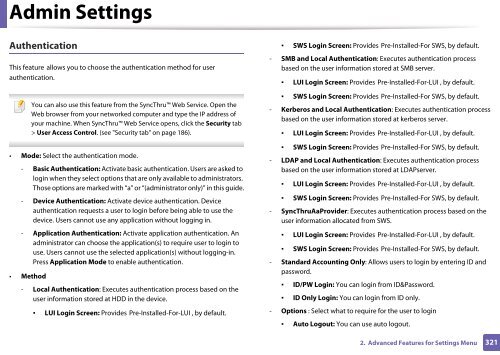Samsung Multifunzione b/n MultiXpress SL-K7400LX (A3) (40 ppm) - User Manual_36.16 MB, pdf, ENGLISH
Samsung Multifunzione b/n MultiXpress SL-K7400LX (A3) (40 ppm) - User Manual_36.16 MB, pdf, ENGLISH
Samsung Multifunzione b/n MultiXpress SL-K7400LX (A3) (40 ppm) - User Manual_36.16 MB, pdf, ENGLISH
Create successful ePaper yourself
Turn your PDF publications into a flip-book with our unique Google optimized e-Paper software.
Admin Settings<br />
Authentication<br />
This feature allows you to choose the authentication method for user<br />
authentication.<br />
You can also use this feature from the SyncThru Web Service. Open the<br />
Web browser from your networked computer and type the IP address of<br />
your machine. When SyncThru Web Service opens, click the Security tab<br />
> <strong>User</strong> Access Control. (see "Security tab" on page 186).<br />
• Mode: Select the authentication mode.<br />
- Basic Authentication: Activate basic authentication. <strong>User</strong>s are asked to<br />
login when they select options that are only available to administrators.<br />
Those options are marked with “a” or “(administrator only)” in this guide.<br />
- Device Authentication: Activate device authentication. Device<br />
authentication requests a user to login before being able to use the<br />
device. <strong>User</strong>s cannot use any application without logging in.<br />
- Application Authentication: Activate application authentication. An<br />
administrator can choose the application(s) to require user to login to<br />
use. <strong>User</strong>s cannot use the selected application(s) without logging-in.<br />
Press Application Mode to enable authentication.<br />
• Method<br />
- Local Authentication: Executes authentication process based on the<br />
user information stored at HDD in the device.<br />
▪<br />
LUI Login Screen: Provides Pre-Installed-For-LUI , by default.<br />
▪<br />
SWS Login Screen: Provides Pre-Installed-For SWS, by default.<br />
- S<strong>MB</strong> and Local Authentication: Executes authentication process<br />
based on the user information stored at S<strong>MB</strong> server.<br />
▪<br />
▪<br />
LUI Login Screen: Provides Pre-Installed-For-LUI , by default.<br />
SWS Login Screen: Provides Pre-Installed-For SWS, by default.<br />
- Kerberos and Local Authentication: Executes authentication process<br />
based on the user information stored at kerberos server.<br />
▪<br />
▪<br />
LUI Login Screen: Provides Pre-Installed-For-LUI , by default.<br />
SWS Login Screen: Provides Pre-Installed-For SWS, by default.<br />
- LDAP and Local Authentication: Executes authentication process<br />
based on the user information stored at LDAPserver.<br />
▪<br />
▪<br />
LUI Login Screen: Provides Pre-Installed-For-LUI , by default.<br />
SWS Login Screen: Provides Pre-Installed-For SWS, by default.<br />
- SyncThruAaProvider: Executes authentication process based on the<br />
user information allocated from SWS.<br />
▪<br />
▪<br />
LUI Login Screen: Provides Pre-Installed-For-LUI , by default.<br />
SWS Login Screen: Provides Pre-Installed-For SWS, by default.<br />
- Standard Accounting Only: Allows users to login by entering ID and<br />
password.<br />
▪<br />
▪<br />
ID/PW Login: You can login from ID&Password.<br />
ID Only Login: You can login from ID only.<br />
- Options : Select what to require for the user to login<br />
▪<br />
Auto Logout: You can use auto logout.<br />
2. Advanced Features for Settings Menu<br />
321
















